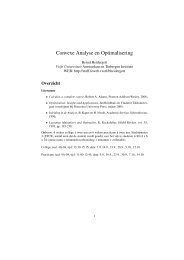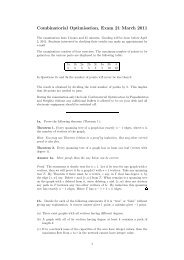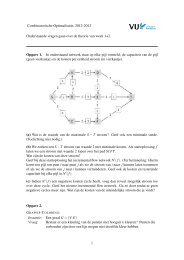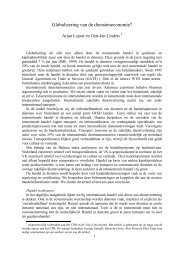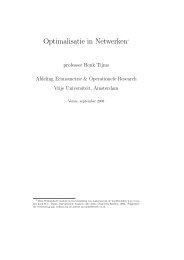Current State of Cross-Border Banking - Vrije Universiteit Amsterdam
Current State of Cross-Border Banking - Vrije Universiteit Amsterdam
Current State of Cross-Border Banking - Vrije Universiteit Amsterdam
You also want an ePaper? Increase the reach of your titles
YUMPU automatically turns print PDFs into web optimized ePapers that Google loves.
For policy purposes, it would be useful to differentiate between cross-border branches and<br />
subsidiaries. The latter are separately licensed and supervised by the host country. It would also be<br />
useful to differentiate between interbank loans and retail and corporate loans to separate financial and<br />
non-financial business. Unfortunately, our data on cross-border banking does not allow to make these<br />
breakdowns.<br />
Financial supervision<br />
The challenge for the effective supervision <strong>of</strong> an international bank is to get an overall view <strong>of</strong> the<br />
financial soundness <strong>of</strong> the bank (consolidated supervision), which is also based on a good knowledge<br />
<strong>of</strong> local conditions in the different markets in which the bank operates (host country perspective).<br />
Cooperation between the consolidated home supervisor and the host supervisors is therefore crucial.<br />
Given the limited number <strong>of</strong> global banks, supervisors have opted for informal arrangements.<br />
Supervisory colleges have been established to bring together the most important supervisors for the<br />
large international banks. A case in point is the cooperation between the Swiss EBK, the FSA and the<br />
New York Fed on Credit Suisse and UBS (McCarthy, 2006). The three supervisors meet half yearly to<br />
share concerns and to form a view on the overall risk pr<strong>of</strong>ile <strong>of</strong> these banks. A wide network <strong>of</strong><br />
bilateral and multilateral Memoranda <strong>of</strong> Understanding (MoUs) exists to support information exchange<br />
and coordination between national supervisors. It should be noted that these MoUs are not legally<br />
binding (Mayes, 2006).<br />
Our assessment is that these arrangements for global banks suffice as only a handful <strong>of</strong> banks are<br />
involved (though this small group <strong>of</strong> global banks comprise the world’s largest banks such as Citigroup<br />
and HSBC). Moreover, there is no international jurisdiction available to go further. Supervision is<br />
related to political sovereignty (Herring and Litan, 1994). The assessment for Europe is different. First,<br />
a jurisdiction to establish formal, binding, arrangements can be made available with the EU. Second,<br />
our figures indicate that there are already 11 banks with significant cross-border business within<br />
Europe and this number is still growing.<br />
The current European structure <strong>of</strong> supervision consists <strong>of</strong> a fairly harmonized regulatory framework<br />
based on EU Directives and coordination between supervisors. In the so-called Lamfalussy approach,<br />
regulatory and supervisory committees are established to speed up the regulatory process and to<br />
foster supervisory convergence. The main aim <strong>of</strong> the supervisory committees is to coordinate policies<br />
by developing common guidelines. At the sub-regional level, supervisors have established institution<br />
specific MoUs (e.g. for Nordea and Fortis) to arrange for cooperation in the day-to-day supervision <strong>of</strong><br />
cross-border banks. As noted before, these MoUs may put a moral obligation on supervisors to<br />
cooperate (in terms <strong>of</strong> game theory, there is a setting <strong>of</strong> repeated play), but does not pose a formal<br />
obligation on supervisors (Mayes, 2006).<br />
The newly emerging European financial landscape confronts the home and host authorities with<br />
complex coordination issues. In the face <strong>of</strong> these challenges, it is questionable whether the current<br />
level <strong>of</strong> cooperation between different national authorities (with a patchwork <strong>of</strong> bilateral and multilateral<br />
14





